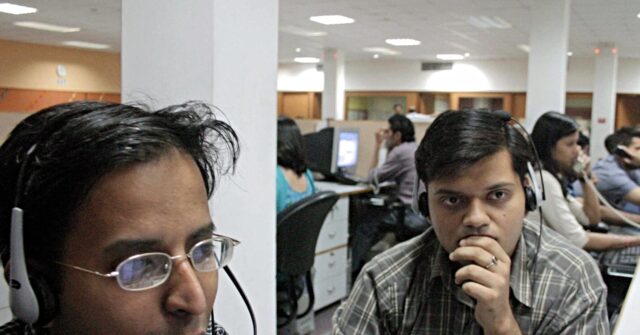India’s government is drafting a bill to expand and accelerate the already huge migration of Indians into jobs throughout the developed world, including white collar careers in the Fortune 500.
The “Overseas Mobility Bill” will help the Indian government train its young people amid recommendations from foreign companies, negotiate labor deals with foreign governments, and help bind overseas Indians to their home countries, according to the English-language Deccan Herald newspaper, which adds:
[Training] young Indians in the future of jobs overseas, negotiating better working conditions for [Indian] workers, and opening new pathways for [Indian] migration will be crucial. The law should empower young Indian migrants to strengthen their leverage and promote their image in destination countries.
The law will include an “Overseas Placement Agency regime, mandatory eMigrate registration for Indians traveling abroad, competitive recruitment processes … and establishing [the Indian city of] Mumbai as a global mobility hub, ” said an association of Indian migrant groups.
The Indian bill comes amid a growing realization in the United States about the scale and damage of India’s transfer of self-serving Indian migrants into American society.
Since the 1990s, and aided by many U.S. CEOs and investors, millions of legal and illegal Indian migrants have cooperatively created many Indian economic enclaves throughout the United States.
These enclaves are in Silicon Valley, Fortune 500 subcontracting, white-collar recruiters, professional-status jobs in the accounting and healthcare sectors, in the West Coast trucking industry, managerial jobs in the franchise hotel and retail sectors, and increasingly, as Wall Street’s CEOs in Fortune 500 jobs.
The archipelago of Indian economic zones largely excludes Americans, including the young American graduates who would otherwise become the next generation of American technology experts, healthcare professionals, truckers, and neighborhood entrepreneurs.
The U.S. public is increasingly aware and hostile to the inflow of migrants. Much of the rational opposition is focused on the H-1B and Optional Practical Training programs, which keep roughly 1 million Indians in white-collar jobs sought by American graduates.
The fast-rising public rejection was a shock to India’s government, which had hoped to use President Donald Trump’s U.S.-India free trade talks to increase the flow of Indian migrants into U.S. jobs.
Similarly, India’s government announced its opposition to Trump’s potentially important $100,000 fee on arriving H-1B workers in 2026. The outsourcing visa “is a mutual benefit,” one spokesman claimed:
Since 2000, the Indian population in the United States has zoomed upwards from a few hundred thousand people to roughly 5 million migrants, largely because of the technology sector’s mass-hiring of Indian visa workers, such as L-1 and H-1B workers. This huge legal inflow has attracted a massive illegal inflow, and has pushed millions of American tech experts out of jobs and many out of the middle class.
India’s economic strategy is built on exporting migrants, who then send vast remittances — and increasingly — outsourced jobs, corporate investments, sensitive private data, and novel technology back to India. The Deccan Herald reported:
India’s diaspora of almost 36 million people is the largest globally. While 19 million have adopted foreign nationality, and 17 million are Non-Resident Indians (NRIs). In the 21st century, India emerged as the largest source country for migration. They include professionals, workers and students who inhabit almost all countries. Indians constitute just 6 per cent of the global migrant community, but the country’s youthful demography could contribute more migrants through the 21st century.
India has already signed “Labor Mobility” deals to export more Indians to countries such as Australia, the United Kingdom, Israel, Germany, and Japan. The deals are often developed in secret with fervent support from the foreign governments, and growing opposition from the public, according to the New York Times:
At an annual India-Japan forum held in New Delhi last December, India’s foreign minister, S. Jaishankar, started the summit by calling for “labor-mobility exchanges.” It topped his list, ahead of defense cooperation, supply chains and chips. In August, the countries started a program that could send 50,000 workers a year from India to Japan.
[…]
Germany’s ambassador to New Delhi, Philipp Ackermann, said his government would have to step up its messaging on bringing in more workers. “We have to make sure that the population understands that legal migration is needed and at the same time to combat illegal immigration,” Mr. Ackermann said. He also said Germany needed to make an “extra effort” to win over Indian workers, most of whom speak English and Hindi, not German.
Established media outlets in advanced countries mostly support the inflow of society-changing Indian migrants, amid skeptical coverage from Breitbart News and a few expert sources.
The New York Times, for example, concluded its article on India’s plans by saying, “The demographics of developed economies, however, make a blunt case in favor of attracting India’s millions of workers.”
Read the full article here


